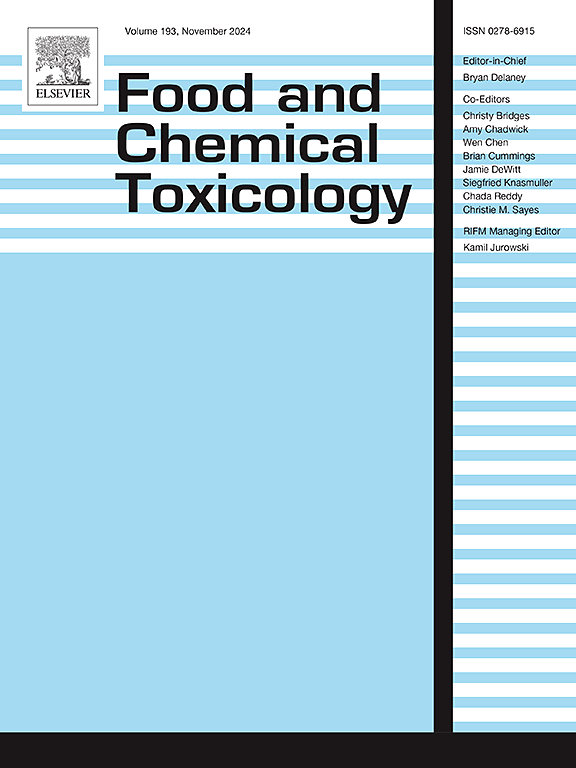研究驱蚊剂在特应性皮炎中的作用
IF 3.9
3区 医学
Q2 FOOD SCIENCE & TECHNOLOGY
引用次数: 0
摘要
蚊虫叮咬是世界范围内各种人群的普遍现象,驱蚊化学成分已被广泛使用。mrcc在当今的环境环境中经常被发现。然而,这些化合物对皮肤状况的影响,特别是对特应性皮炎(AD)的影响尚不清楚。在这项研究中,我们分析了三种市售mrcc:避蚊胺(N,N-二乙基-3-甲基苯甲酰胺),IR3535(丁基乙基氨基丙酸乙酯)和皮卡瑞丁(2-(2-羟乙基)-哌啶羧酸1-甲酯)。利用各种数据库进行了全面分析,以确定与这些mrcc暴露相关的潜在靶标及其与AD的相关性。基因本体(GO)和京都基因与基因组百科全书(KEGG)途径富集分析显示,暴露于这些mrcc会影响炎症相关途径。此外,分子对接研究表明,避蚊胺、IR3535和皮卡瑞丁对关键核心靶点和受体蛋白具有显著的结合亲和力。此外,我们还进行了一系列细胞实验,以经验评估这三种mrcc对诱导AD的实际作用。结果表明,mrcc可能通过影响炎症过程促进AD的进展。本研究为理解mrcc与AD风险之间的关系提供了一个概念性框架,从而有助于制定旨在减轻其对皮肤疾病影响的策略。本文章由计算机程序翻译,如有差异,请以英文原文为准。
Investigating the role of mosquito repellents in atopic dermatitis
Mosquito bites are prevalent occurrences among various populations worldwide, mosquito repellent chemical components (MRCCs) have been extensively utilized. MRCCs have been frequently identified in environmental settings nowadays. However, the implications of these compounds on skin conditions, particularly Atopic Dermatitis (AD), are not well understood. In this investigation, we analyzed three commercially available MRCCs: DEET (N,N-diethyl-3-methylbenzamide), IR3535 (ethyl butylacetylaminopropionate), and picaridin (2-(2-hydroxyethyl)-piperidinecarboxylic acid 1-methyl ester). A comprehensive analysis was conducted utilizing various databases to identify potential targets associated with exposure to these MRCCs and their correlation with AD. Gene Ontology (GO) and Kyoto Encyclopedia of Genes and Genomes (KEGG) pathway enrichment analyses revealed that exposure to these MRCCs influences inflammation-related pathways. Additionally, molecular docking studies indicated significant binding affinities of DEET, IR3535, and picaridin to critical core targets and receptor proteins. Furthermore, a series of cellular assays were conducted to empirically evaluate the actual effects of these three MRCCs on the induction of AD. The results suggest that MRCCs may facilitate the progression of AD by influencing inflammatory processes. This study provides a conceptual framework for understanding the association between MRCCs and the risk of AD, thereby contributing to the formulation of strategies aimed at mitigating their effects on dermatological disorders.
求助全文
通过发布文献求助,成功后即可免费获取论文全文。
去求助
来源期刊

Food and Chemical Toxicology
工程技术-毒理学
CiteScore
10.90
自引率
4.70%
发文量
651
审稿时长
31 days
期刊介绍:
Food and Chemical Toxicology (FCT), an internationally renowned journal, that publishes original research articles and reviews on toxic effects, in animals and humans, of natural or synthetic chemicals occurring in the human environment with particular emphasis on food, drugs, and chemicals, including agricultural and industrial safety, and consumer product safety. Areas such as safety evaluation of novel foods and ingredients, biotechnologically-derived products, and nanomaterials are included in the scope of the journal. FCT also encourages submission of papers on inter-relationships between nutrition and toxicology and on in vitro techniques, particularly those fostering the 3 Rs.
The principal aim of the journal is to publish high impact, scholarly work and to serve as a multidisciplinary forum for research in toxicology. Papers submitted will be judged on the basis of scientific originality and contribution to the field, quality and subject matter. Studies should address at least one of the following:
-Adverse physiological/biochemical, or pathological changes induced by specific defined substances
-New techniques for assessing potential toxicity, including molecular biology
-Mechanisms underlying toxic phenomena
-Toxicological examinations of specific chemicals or consumer products, both those showing adverse effects and those demonstrating safety, that meet current standards of scientific acceptability.
Authors must clearly and briefly identify what novel toxic effect (s) or toxic mechanism (s) of the chemical are being reported and what their significance is in the abstract. Furthermore, sufficient doses should be included in order to provide information on NOAEL/LOAEL values.
 求助内容:
求助内容: 应助结果提醒方式:
应助结果提醒方式:


